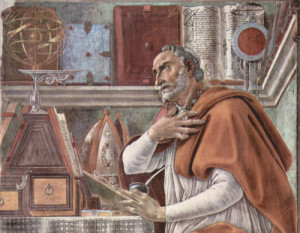
One of the treasures of the Ognissanti Church in Florence has been missing for years. Ognissanti, known for being the burial place of Sandro Botticelli and Amerigo Vespucci, and for its huge and recently restored Giotto crucifix, is a pilgrimage site for art lovers and romantics. In 1480, the Vespucci family commissioned a pair of frescos that face each other across the main nave:on the left, Saint Jerome at his desk, painted by Domenico Ghirlandaio; on the right, Saint Augustine in his study by Botticelli.
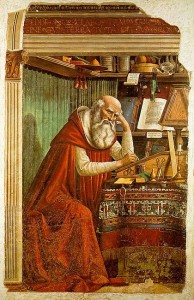
Domenico Ghirlandaio, St. Jerome in his Study, 1480.
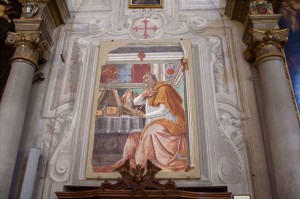
Sandro Botticelli, Saint Augustine in his Study, 1480.
Sadly, the Botticelli is no longer there. In its place is a photograph of the fresco. For years now, whenever I visit Florence, I go to Ognissanti hoping to see the original fresco has returned, only to be disappointed. The print at this point is fading badly, its colors turning a pale blue like an old family Kodachrome.
While I always assumed the fresco was only temporarily removed for restoration, about a month ago I decided to investigate. On a cold February morning, I approached a monk who was huddled in a corner near the entrance, wrapped in his robes, a stocking cap under his hood. I recognized him from my previous visits as the guardian of the church. He appears to be Asian, possibly from the Philippines. Even though we have never talked, I had a fond feeling for him because I believed he was responsible for the lovely recorded religious music that fills the church.
I asked in my weak Italian, “the Botticelli fresco, is it being restored?” The question seemed to rouse him. Over the next ten minutes, I would get an earful from the monk in a mix of Italian and English.
“In restauro? (restoration?) That’s what they said. Two years ago! But it is not being restored at all.”
“What do you mean?”
“It is on tour of Japan to earn money for the state.”
A dike had burst. I learned from the monk that Ognissanti Church is no longer Franciscan, but controlled by the State. [He seemed to attribute this change of ownership to Napoleon.] The Franciscans now act only as care-takers.
According to my new comrade, what’s worse is the State is now threatening to remove two other prizes of Ognissanti, under the guise of restoration. The monk pointed to two Ghirlandaios, neither of which appears to be in need of attention. The Franciscans are helpless to stop them.
Of course, this is an old story – the powerful stripping religious sites of their treasures for their own profit or gain. Our beloved museums would hardly exist without this tradition.
 For example, the grand first room of the Uffizi museum with the enormous enthroned Madonnas with angels by Giotto, Cimabue, and Duccio is far from what the artists and their patrons every imagined. Cimabue’s altarpiece was once in Santa Trinita. The Giotto was once the high altar of Ognissanti itself. After five hundred years in their central role for celebrating the mass, both were removed in 1810 to be part of a new museum at the Accademia. [This may explain the monk’s reference to Napoleon, since during this period he had set up his brother to rule Italy.] About a hundred years later, the giant altarpieces were transported across the center of Florence to their current home. They were joined in the Uffizi by Santa Maria Novella’s Duccio in 1949 — as a “permanent loan” according to its label.
For example, the grand first room of the Uffizi museum with the enormous enthroned Madonnas with angels by Giotto, Cimabue, and Duccio is far from what the artists and their patrons every imagined. Cimabue’s altarpiece was once in Santa Trinita. The Giotto was once the high altar of Ognissanti itself. After five hundred years in their central role for celebrating the mass, both were removed in 1810 to be part of a new museum at the Accademia. [This may explain the monk’s reference to Napoleon, since during this period he had set up his brother to rule Italy.] About a hundred years later, the giant altarpieces were transported across the center of Florence to their current home. They were joined in the Uffizi by Santa Maria Novella’s Duccio in 1949 — as a “permanent loan” according to its label.
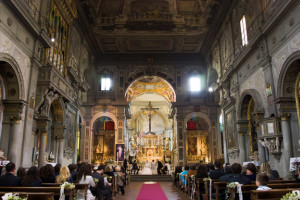
Service at Chiesa di Ognissanti, Florence.
We who enjoy these great museums can say to ourselves that ‘these are old stories’ and, of course, they are. The Elgin Marbles were torn off the facade of the Parthenon in Athens to be placed in the British Museum. Aboriginal peoples all over the world have seen their sacred objects and even their dead exhibited as ‘primitive artifacts’ in museums. In order for great institutions like museums to continue to exist, visitors must engage in a kind of cultural amnesia. We have to close our eyes, as it were, to how these wonderful objects ended up on the walls and in the cases, in order gaze on these masterpieces.
The angry monk’s tale (and you haven’t lived until you’ve seen an angry Franciscan) reminds us that this kind of crime continues to this day, even if on a smaller scale than in Napoleon’s time. When I asked the monk, when he expected the Botticelli to return, he replied sarcastically, “Maybe in two more years.” So, at Ognissanti, once again a neighborhood’s sacred object has been taken by government order (in this case, the Cultural Ministry). And more of the church’s paintings are threatened.
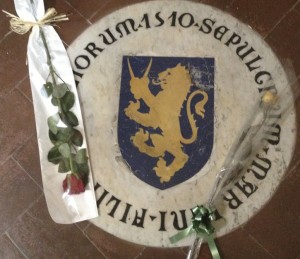
Tomb of Botticelli, Chiesa di Ognissanti.
If they are ultimately removed, it will be a loss not just for the members of this church, but to art lovers, too. One of the great pleasures of visiting a church like Ognissanti is seeing centuries-old art, not against pure white walls with perfect gallery lighting, but where it was meant to be seen. Perhaps in shadows and a chilly stone building, but nonetheless in the exact place the artist had in mind from its inception.
After getting my earful from the monk (who would not be satisfied until I promised to write this story), I couldn’t help thinking Botticelli must be rolling over in his tomb, just a few yards away from his missing fresco.

I was also disappointed that the St Augustine was missing when I visited Ognissanti a few weeks ago, and I hope it is put back in place soon.
But I think it’s a bit unfair to say that it “on tour in Japan to make money for the state”. It was actually part of a reasonably big exhibition at the National Gallery in Tokyo “Botticelli et il suo tempo” which ran from January to early April. It seems to me that it is quite legitimate for the Italian government to organise such exhibitions overseas and that developing an interest in Italian culture was surely a bigger motive than making money. Presumably the current renovation works in the Uffizi were a consideration in the timing of the exhibition. I imagine the St Augustine was included since it is one of the few frescos by the artist that can be transported.
You can see the list of works exhibited at http://www.tobikan.jp/media/pdf/20160114_botticelli_worklist.pdf
The on tour comment was not mine, but the Franciscan monk’s. Thank you for clearing up St. Augustine’s present whereabouts. Since the exhibition in Tokyo ended on April 3rd, perhaps his return is near. I’ll be in Florence next week and hope to see him (or at least give the monk in Ognissanti an update). Thanks again for your comment.
Pingback: Update on the Missing Botticelli | Lewis Art Café
This seems to be a little matter, but after reading the article, I cannot help but ask, was the monk, the one who made the “on tour comment” from the Philippines?
Yes, he was born in the Philippines.